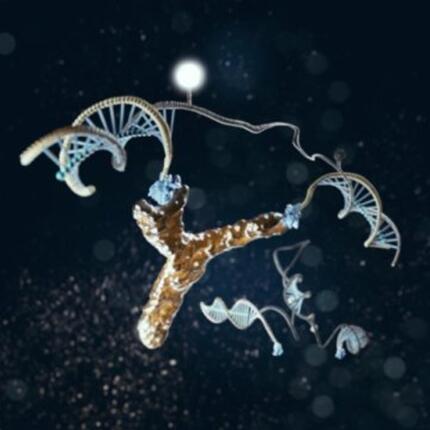中国病毒学论坛|我们一直在坚持!
标题: 可以快速检测病毒的DNA纳米“机器” [打印本页]
作者: ipsvirus 时间: 2015-11-10 09:49
标题: 可以快速检测病毒的DNA纳米“机器”

发光的DNA与抗体结合,纳米机器正在运转。
近日,一项研究可能会彻底改变冗长,繁琐,昂贵的抗体检测流程,来帮助医生们更好地诊断传染病和自身免疫性疾病,如类风湿性关节炎和艾滋病(HIV)。一个国际研究团队设计并合成了一台纳米级别的DNA“机器”,该“机器”具有自定义修改功能,这使得它们可以识别特殊的目标抗体。本月,这个新方法发表在《德国应用化学杂志》(Angewandte Chemie)上,并且该研究团队承诺会继续研发快速,廉价的床旁抗体检测技术。这项技术有助于我们及早发现病情,节约医疗成本。
当抗体与DNA结合时,结构会发生改变或转换,进而产生光信号。该传感器不仅不需要化学活化,还可以在五分钟之内做出反应,这些特点使得我们可以轻松地检测目标抗体,即使面对的是复杂的临床样品,如血清。
罗马大学(the University of Rome)Francesco Ricci教授是这项研究的高级合作者。他介绍道,“较高的通用性是这种方法的优点之一。实际上,这个DNA纳米机器可以被自定义修饰以便检测各类抗体,而这使得我们的平台适用于多种疾病的检测。”
蒙特利尔大学(the University of Montreal)Vallée-Bélisle教授是这篇论文的另一位合作者。他补充道,“比起现有的抗体检测方法,我们的模块化平台具有很多优势。它可以快速检测,不需要化学试剂,而且将来可能被证明可以应用于各种不同的领域,如床旁诊断和生物成像。”
蒙特利尔大学(the University of Montreal)Vallée-Bélisle教授是这篇论文的另一位合作者。他补充道,“比起现有的抗体检测方法,我们的模块化平台具有很多优势。它可以快速检测,不需要化学试剂,而且将来有望应用于各种不同的领域,如床旁诊断和生物成像。”
“该检测技术的另一个优势在于成本低廉,”美国加州大学圣芭芭拉分校(University of California, Santa Barbara)的KevinPlaxco教授说道,“我们单次的检测费用仅为15美分,比其他定量检测方法更具优势。”
Simona Ranallo是罗马大学(the University of Rome)Ricci团队的博士生,同时也是这篇论文的第一作者。他评价道,“我们对已取得的初步成果感到兴奋,现在我们正在设法改进这个传感器平台。比如,我们正设法利用手机检测纳米开关信号,这将使我们的检测平台能够造福于每个人!我们正设法实现这个想法。此外,我们还计划与疾病诊断公司开展合作。”
来源:生物探索
作者: ipsvirus 时间: 2015-11-10 09:51
A Modular, DNA-Based Beacon for Single-Step Fluorescence Detection of Antibodies and Other Proteins
Simona Ranallo, Marianna Rossetti, Prof. Kevin W. Plaxco, Prof. Alexis Vallée-Bélisle, Prof. Francesco Ricci
Abstract
A versatile platform for the one-step fluorescence detection of both monovalent and multivalent proteins has been developed. This system is based on a conformation-switching stem–loop DNA scaffold that presents a small-molecule, polypeptide, or nucleic-acid recognition element on each of its two stem strands. The steric strain associated with the binding of one (multivalent) or two (monovalent) target molecules to these elements opens the stem, enhancing the emission of an attached fluorophore/quencher pair. The sensors respond rapidly (<10 min) and selectively, enabling the facile detection of specific proteins even in complex samples, such as blood serum. The versatility of the platform was demonstrated by detecting five bivalent proteins (four antibodies and the chemokine platelet-derived growth factor) and two monovalent proteins (a Fab fragment and the transcription factor TBP) with low nanomolar detection limits and no detectable cross-reactivity.
http://onlinelibrary.wiley.com/d ... .201505179/abstract
| 欢迎光临 中国病毒学论坛|我们一直在坚持! (http://virology.com.cn/) |
Powered by Discuz! X3.2 |

